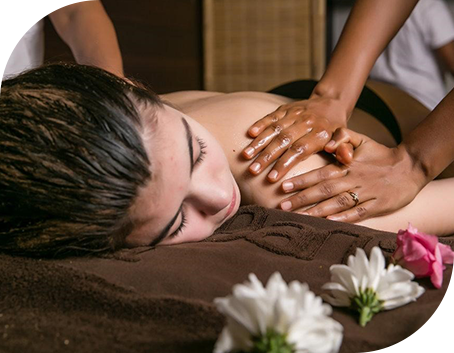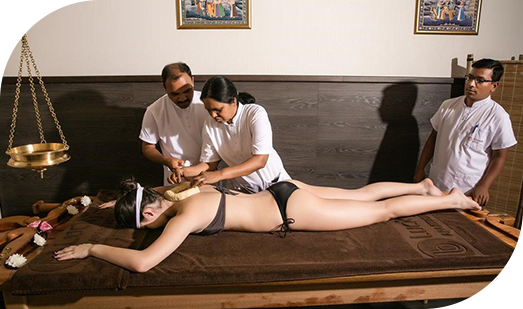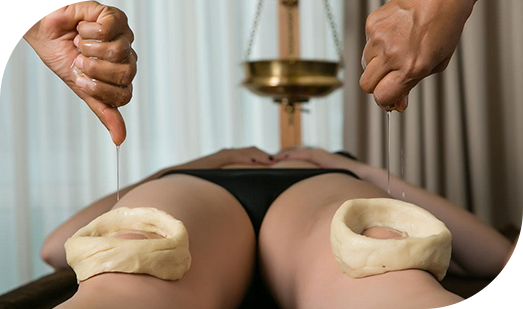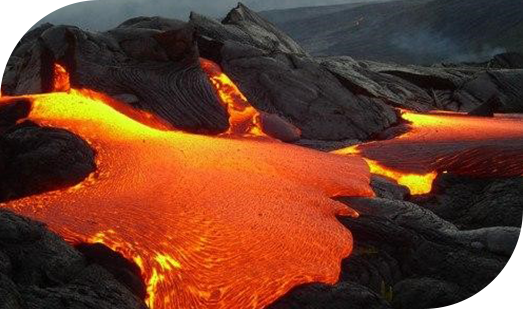Ayurvedic massage – how is it done and what benefits does it bring?
- Physical
- Mental
- Emotional
- Energetic

And as a result – also as a natural way to achieve good health and improved psycho-emotional balance.
What are Ayurvedic massages?
During this massage, the body is treated with individually selected and preheated herbal oils.
The oils penetrate the skin, tissues and organs, helping to cleanse, nourish and heal them.
For this purpose, the touch and movements in Ayurvedic massage are tailored to the muscles, lymphatic and nervous system so that the procedure stimulates their good functioning.


Most of the MARMA points are located in the head and neck area – that’s why every Ayurvedic massage starts from the head.
When properly selected according to the type of person and conducted by an experienced Ayurvedic therapist, this massage has the potential to:
• Detoxify the body;
• Filter unnecessary substances in the body;
• Provide vitality.
Ayurvedic massages can serve both for the ongoing prevention and relief of pain, as well as for the treatment of various health conditions and diseases.
Why Ayurveda?
Translated from Sanskrit, Ayurveda means “science of life” or “longevity practice”. This type of alternative medicine was developed by the ancient yogis who, through centuries of observation, practice, discussion and meditation, arrived at their own system of knowledge about the human body.
These texts are the basis on which our therapists are guided to determine the type of person, select the individual therapeutic oils for them and perform the procedure so that it achieves the desired results.
This happens after an individual Ayurvedic consultation.
What are the Ayurvedic types according to which procedures are selected?
Vata dosha
It consists of the elements ether and air.
Ether represents the space we absorb with physical presence.
The air element is the air that is breathed in and transformed into life energy.

• Bones become thinner and more brittle.
• The joints become stiff and the movements are limited.
• Absorption of nutrients deteriorates.
• There are changes in body composition and weight loss.
• There may be restlessness, irritability or insomnia.
• Lack of concentration and difficulties with long-term memory are noted.
During it, warm and heating oils are used to penetrate deep into the skin.
Sesame, almond or olive oil is most often used in these massages.
A few drops of jasmine, rose, musk, lotus or clove essential oils are added to them.
Pitta dosha
It consists of the elements fire and water.
Fire is obtained from the digestion of food and the energy derived from it.
Water represents the absorption of all fluids for metabolic processes.

• Indigestion, gas and bloating.
• Constant desire to take food and liquids.
• Eye and vision problems.
• Impaired judgment, headaches and migraines.
• Swelling of the lymph.
• Appearance of pigmentation.
• Risk of cardiovascular disease and blood vessel problems.
• Hyperactivity, overexcitement, nervousness or irritability.
Essential oils of sandalwood, patchouli, lavender, peppermint or saffron can be added to the base oil.
In winter, massages can be done with warmed ghee, sesame oil or Ayurvedic Pitta oil.
Daily massage will bring balance and confidence in the daily life of people with Pitta dosha disorders.
Kapha dosha
It consists of the elements earth and water.
Earth is the structure and weight of our body.
And water – as we have already explained – is the absorption of all liquids by the body for metabolic processes.

• Weight gain.
• Depressive states, fear and worries.
• Strong attachment and symptoms of lethargy.
• Propensity to develop diabetes.
• Impaired long-term memory.
• Frequent colds, lung pain and sinusitis.
• Phlegm, secretions, cough and increased cholesterol.
• Heaviness, fatigue, lack of desire to move, swelling.
To restore the balance, Ayurvedic massages are performed with warmed oils – mustard, sunflower, corn or linseed.
Dry massages (udavartam) are also suitable for activating and expelling the accumulated mucus in the body.
They are made using specially prepared cotton bags filled with herbs and dipped in warm oil.
The massage is performed by two therapists with energetic pats on the whole body.
In this way, blood circulation and the lymphatic system are activated.
Regular Ayurvedic massage helps people with Kapha dosha to be energetic, fit and positive.
What are the results of Ayurvedic massage?
The result is visible on the condition of the skin and tangible on the state of health. Through the right combination of procedures, not only the symptoms but also the root causes of all the energy disturbances described above can be affected.
Thus, the effect will be as comprehensive as possible both on a physical and mental level.
With the help of our Ayurvedic therapists, you can walk all the way back to balance – to being healthy, feeling good in your own skin, and loving yourself and the world around you again.

